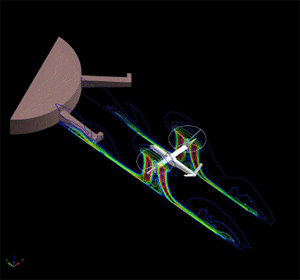


Case Study 1: LCTR2 Near a Terminal

Figure 1: LCTR2 Rotor wake impingemet on the building.
In this case study, the LCTR2 (Large Civil Tilt Rotor) was simulated while taking off from an airport terminal. Such studies are crucial for determining the aerodynamic impact of rotorcrafts operating close to terminal areas, thereby helping in the formulation of operational and safety guidelines for V/STOL aircrafts. A full knowledge of the rotor flowfield is essential to obtain the loads on the terminal building and operational conditions such as the noise generated by the rotorcraft.
Case Study 2: Georgia Tech Body in Forward Flight
RotCFD is an ideal tool for studying the interference effects of rotor-body configurations operating under different flight conditions. The forces and moments on the airframe can be calculated and visualized in real-time. The Georgia Tech body is a classic example case used for such studies. It consists of a cylindrical fuselage, with a single main rotor operating at an advance ratio of 3.32.
Case Study 3: Rotating Maneuver around a BuildingRotCFD is capable of simulating moving rotors, such as translating or rotating maneuvers, with negligible increase in computational expense. In this case, an isolated rotating about a building at a constant rotational speed is depicted. The pressure signature on the building and dynamically changing flowfield in the vicinity of the maneuvering rotor are presented.
Case Study 4: Acoustic Footprint of an Isolated Rotor in HoverIn this case-study, the acoustic footprint of an isolated rotor is presented. The test rotor is rotating at an RPM 1250, with a collective pitch of 12 degrees. An acoustic grid is a collection of observation points in the computational domain for which the sound pressure levels are calculated. The thickness and loading sound pressure level are computed, as well as the overall sound pressure level. The inbuilt plotting application in RotCFD is used to extract the time history and frequency variation of sound pressure levels with respect to a given observation point.
